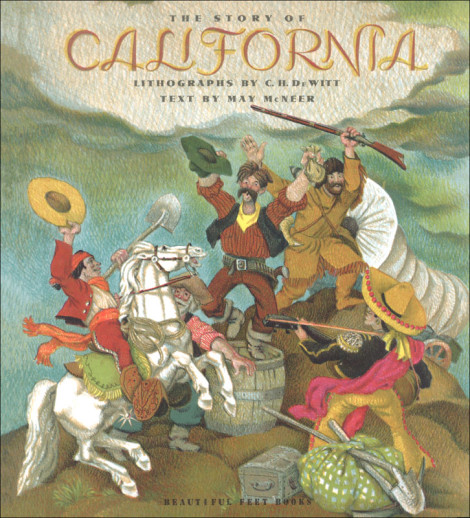We use cookies to make your experience better. To comply with the new e-Privacy directive, we need to ask for your consent to set the cookies. Learn more.
Story of California
This text is a reprint of a 1940's May McNeer book, with original lithographs by C.H. DeWitt. The lovely narrative has been slightly revised and updated for 21st century readers, providing vignettes of several key elements of California's history and key contributions: missions, trappers, Sutter's Fort, San Francisco, the Red Woods, the railroads, produce, and the multiple cultures and traditions that comprise this “melting pot". 10"x 11", 33 pgs, pb.
The award-winning storyteller, May McNeer brings her delightful style to the amazing, wonderful, and dramatic story of California. A classic book revived from the mid-twentieth century, McNeer's history is made extraordinary by the pairing with a master lithographer–Cornelius DeWitt–who creates sweeping spreads of the Golden state's dramatic story. California's stunning coastline, its agriculture, Missions, giant redwoods, Rancherias, and the wild days of the Gold Rush, are vividly and unforgettably brought to life in this lovely reissue.
| Product Format: | Paperback |
|---|---|
| Grades: | 1-6 |
| Brand: | Beautiful Feet Books |
| Author: | May McNeer |
| ISBN: | 9781893103849 |
| Length in Inches: | 11 |
| Width in Inches: | 10.0625 |
| Height in Inches: | 0.125 |
| Weight in Pounds: | 0.3625 |
Rated 5 stars by 100% of reviewers
Rated 4 stars by 0% of reviewers
Rated 3 stars by 0% of reviewers
Rated 2 stars by 0% of reviewers
Rated 1 star by 0% of reviewers
- Start typing and we'll see if it was already asked and answered.
- If there aren't already some matches, submit a new question.
- You'll get fast answers from customers who really own the item(s) and from our product experts. (About half the time you'll get an answer in under 2 hours!)
- Which items will best meet your needs
- What customers who own an item think of it
- How to use, fix, or take care of an item
- Product information
- General advice related to the types of products we sell
- Our store policies
For questions about an order you have placed, please contact customer support directly.















This is a supplement for my Abeka grade 4 history curriculum. I will use this as a resource for a unit on California history. I trust Beautiful Feet books to have a conservative perspective.